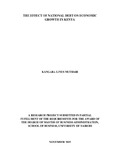| dc.description.abstract | Kenya recorded a Government Debt to GDP of 49.80 percent of the country's Gross Domestic Product in 2014. Government Debt to GDP in Kenya averaged 55.06 percent from 1998 until 2014, reaching an all-time high of 78.30 percent in 2000 and a record low of 42.80 percent in 2008. However, this has been fluctuating overtime due to lack of economic stability in Kenya. This study therefore sought to investigate the effect of national debt on economic growth in Kenya. To achieve this goal, the study used a descriptive research design. The used secondary data for a period of ten years (2005-2014), this data obtained from Central bank of Kenya. A regression model, descriptive statistics and Correlation analysis were used for analyzing the data. The study concluded that national debt was negatively related to economic growth in Kenya. This implied that increase in national debt impacted negatively on economic growth. The regression model used in this study was statistically insignificant in explaining the effect of national debt on economic growth in Kenya. Further net exports and consumption contributed positively to GDP. An increase in national debt, interest rates and inflation was found to impact negatively on economic growth. Due to time and funding constraints the study limited itself to Kenya only. It would have been more appropriate for the researcher to conduct a comparative study in East Africa and other neighboring countries that are similar in terms size and areas of intervention, the findings can then be compared and conclusion drawn on concrete facts. The Kenya government should find ways of increasing consumption and net exports in order to enhance economic growth. The Kenya government should look for alternative means of raising revenues other than use of debt either internally or externally. This country should try and raise adequate revenues through taxes, treasury bills and bonds and privatization to mitigate national debt and borrowing in order to boost economic growth. A comparative study should be conducted for a period of more than ten years in order to obtain more detailed and conclusive results that can be used to make generalization in another middle income country like Kenya that is similar in terms of size and areas of intervention. Findings can be compared and conclusion made on concrete facts. | en_US |

